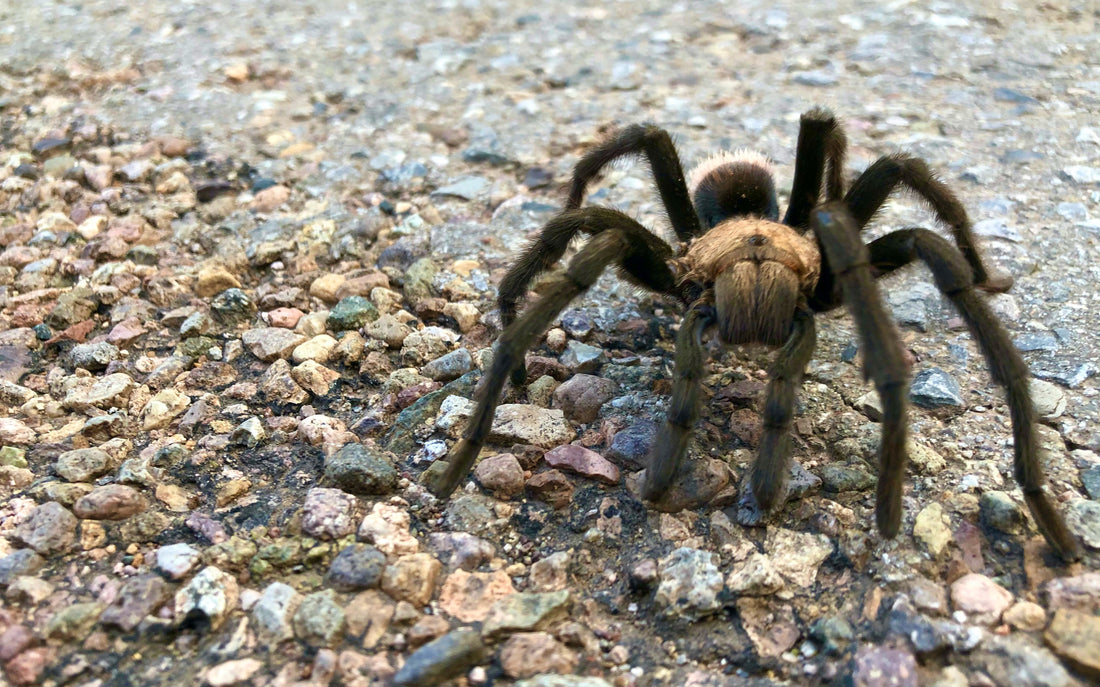There are currently 1040 known species of tarantula living on every continent in the world, except for Antarctica. Of those 1040 known species, the greater bulk of them are “New World” tarantulas endemic to the jungles of South America. But did you know there are 29 unique species of Tarantula that are native to the United States?
Where Do Tarantulas Live in the U.S.?
Over a fifth of the states in the United States have a native tarantula population. Where can you expect to find them?
With a few exceptions, the tarantulas that live in the U.S. prefer the warmer, drier conditions of the American Southwest. You may come across a tarantula in the wild if you live in or visit:
- Texas
- California
- Nevada
- Colorado
- Oklahoma
- Kansas
- Arkansas
- Missouri
- Nebraska
- New Mexico
- Arizona
- Utah
But there’s one additional state we can add to this list.
In 1996 researchers discovered a Mexican Red Rump tarantula living in a citrus grove in Florida. After further observation, it became apparent that this species had been living and breeding in Florida for some time. Today you can find it in numerous Florida citrus groves, swamps, and along canals.
You may also come across a Florida Golden Chestnut tarantula in the state, but it’s unlikely. The species was found only in the Florida Keys, and only a single female was caught. It’s extremely reclusive and rarely leaves its burrow.
Neither the Mexican Red Rump nor the Florida Golden Chestnut tarantulas are native to Florida. Both originate from South America: the Red Rump from Honduras, Nicaragua, and Costa Rica, and the Golden Chestnut from Mexico.
So how did they get to Florida? There are a number of possibilities, but most researchers and hobbyists believe the most likely case is that these spiders hitched rides as stowaways in cargo containers (in true “Arachnophobia” fashion). It’s also possible that some tarantula hobbyists have released their pets into the wild.
With these exceptions aside, the tarantula species native to the United States live in the more arid regions of the country, preferring the warm, dry Southwestern air.
Tarantulas in the U.S.: A List of North American Tarantulas
Until as recently as 2016, arachnologists generally agreed that there were 55 unique species of tarantulas native to the United States. However, they also recognized that the naming and classifying of those 55 species was a complete mess. Work was needed to clean up the mess.
Arachnologists Chris Hamilton, Brent Hendrixson, and Jason Bond undertook the task. Their exhaustive research project was published by ZooKeys journal in February of 2016, and their findings were nothing short of astonishing.
After conducting an in-depth analysis of all 55 “known” species of tarantulas in the U.S., they proposed 33 new “synonymies” – meaning that species once thought to be distinct would now be classified as identical.
For example: the Aphonopelma apacheum, minchi, rothi, schmidti, and stahnkei were all regrouped into the single species Aphonopelma chalodes.
These new groupings reduced the number of tarantula species native to the U.S. to just 29. But that’s not even the most extraordinary finding in this study.
Of those 29 species of native U.S. tarantulas, 14 of them were “new” – i.e. previously unclassified – and eight of them were dwarf species.
So what are these 29 tarantula species native to the U.S.? All of the tarantulas in the U.S. belong to the Aphonopelma genus of the Mygalomorphae infraorder of spider. Since “aphonopelma” is a fairly long word, it’s typically abbreviated prior to giving the name of the individual species. Here they are:
- A. anax (Texas Tan)
- A. armada (Texas Black Spot)
- A. atomicum
- A. catalina
- A. chalcodes (Arizona Blond)
- A. chiricahua
- A. eutylenum (California Ebony)
- A. gabeli
- A. hentzi (Texas Brown)
- A. icenoglei
- A. iodius (Desert Tarantula)
- A. johnnycashi
- A. joshua
- A. madera
- A. mareki
- A. marxi
- A. moderatum (Rio Grande Gold)
- A. moellendorfi
- A. mojave
- A. paloma (Paloma Dwarf)
- A. parvum
- A. peloncillo (Peloncillo Mountains Tarantula)
- A. phasmus
- A. prenticei
- A. saguaro
- A. steindachneri (Ebony Tarantula)
- A. superstitionense
- A. vorhiesi (Tucson Bronze)
- A. xwalxwal
Tarantulas in the U.S. Commonly Kept as Pets
So, with all these Ts running around the American Southwest, which ones are commonly kept as pets by T-keepers? These are the top three:
Texas Brown (A. hentzi)
One of the most common species in the wild, the Texas Brown is also a very popular pet tarantula. Growing to roughly 5 inches long, this terrestrial T is known to be quite docile. Females can live to be over 30 years old.
Arizona Blond (A. chalcodes)
Originating in the Arizona deserts, the Arizona Blond grows to be slightly larger than the Texas Brown, often reaching sizes of 6 inches long. Also a terrestrial species, the Arizona Blond hails from southern Arizona. Very docile and calm in general, this species makes a great beginner T.
Ebony Tarantula (A. steindachneri)
Found in southern California and Baja California, Mexico, the Ebony Tarantula grows to be 4 to 5 inches long. It’s very docile, very slow growing, and slow moving. Although that may make you conclude that it’s a great starter T, you’ll have to be willing to invest. An Ebony Ts can run you $100 or more to find captive-bred.
Takeaway: Of the 1040 known species of tarantulas, 29 of them are endemic to the Southwest region of the United States. Although you may have trouble coming across one in the wild, there’s a good chance you might know a T-keeper who keeps one of these North American tarantula species as a pet. The Texas Brown, Arizona Blond, and Ebony Tarantula are very popular tarantula species in the hobby.








